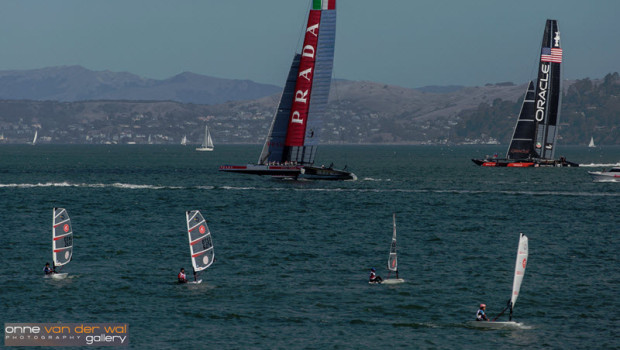What the America’s Cup means for Dinghy Sailing (and what it could mean)
Published on February 9th, 2015
by Damian Lord, The Final Beat
There is an undeniable fact that sailing should try to learn from the successes and mistakes of other sports, and when Terry Greenwood spoke at the recent ISS conference he gave us an opportunity to do so. He offered many useful insights into what British Cycling (which has increased participation 5-fold) has done well and less well, and one of the key points that struck me was this:
“Elite success and mass participation are not mutually exclusive – one most certainly needs the other. It’s for this reason that elite success and participation sit side-by-side at the table as key objectives in British Cycling’s vision.”
He also said this:
“We know that that nucleus of participation and membership cannot grow unless we are pushing out those boundaries of awareness and familiarity…Those boundaries are pushed out when we win things, when the media are all over our sport.
“However, and here’s the rub, unless we’re in a position to capitalise on that familiarity and awareness the moment it’s achieved we risk losing the opportunity. If efforts to increase participation come in response to elite success they’re too late, and the moment will have gone before anything materialises.”
(You can click here to listen to this section of his presentation)
Last year we had the America’s Cup. And it was big news. For once sailing was in the sport pages of daily newspapers. It was even on the front cover of daily newspapers, and not just in one country – the boat was American, the skipper was Australian, the tactician (eventually) was British, the brilliant losers were from New Zealand. There were entrants from Sweden and Italy, and sailors from the Netherlands and Antigua and Barbuda. That makes the America’s Cup big news in a lot of countries.
But how prepared was sailing to capitalise on all this publicity?
Some might argue that no-one could have predicted the nature of Oracle Team USA’s comeback, and the level of coverage that this would produce. Of course, this is true.
But the fact is that sailing has three flagship events: the America’s Cup, the Olympics, and the Volvo Ocean Race.
That makes the America’s Cup one of our main opportunities to push out the boundaries of awareness. In this sense, it doesn’t matter that we couldn’t have predicted how widely the Cup would have been followed. All that really matters is that we weren’t prepared to take advantage of whatever publicity came from the event.
The people that run the cup and the sailing authorities in all our various countries, but most particularly in the countries most involved, should have been preparing to take advantage of all the publicity that came our way…
– How many sailing organisations contacted all their member clubs with suggestions for events that could be run whilst the battle for the cup was taking place?
– How many had a clear pathway for people that had never sailed before – someone that watched the cup and thought “I’d like to try that”?
– Could a non-sailor watch the cup, and then find out simply and easily how they could get involved in sailing?
Clubs work hard to increase their membership, but they rarely have a load of experts with time to spare to come up with ideas, figure out how to implement them, and then successfully produce them within a limited time frame. This should be where sailing organisations step in.
There’s a temptation to think of all this as a once-off, an anomaly. It isn’t. We routinely fail to take advantage of the increasingly good Olympic coverage, especially in countries that medal.
And it’s not just sailing. When England won the Rugby World Cup in 2003 there was a massive surge of interest in the sport. It was entirely wasted.
Tennis (another sport struggling to increase participation) has this problem every year, with the Wimbledon Effect being the obvious example. Thousands of people head out to play tennis for two weeks, and then disappear for the other fifty.
And how many Olympics have passed without significantly raising the level of participation in sport? London 2012 had this as a specific aim, but it doesn’t seem to have delivered very significant results.
So what can be done to make the most of these big events? Here’s a few ideas:
Start providing clubs and classes with ideas as to how they can piggy-back on the coverage of these events well in advance.
Sailing Associations could try providing clubs with information and templates for events that could run concurrent with the America’s Cup, Olympics, and the Volvo Ocean Race. For example:
* As soon as the course that will be used for the America’s Cup races is decided, it is communicated to the clubs. They can then use this course occasionally in normal club racing to build familiarity and connection to the event.
* They are encouraged to build into their calendar an event that uses the course(s) and runs on a weekend when the Cup is on. Why not have clubs run a match racing event whilst the cup is on, using the same (or similar) courses.
* They are given templates for the Sailing Instructions and event organisation.
– Take the pain out of having to design an event from scratch by providing as much of the necessary documentation for the clubs.
– Give advice on timing and course setting so that the event is easy to run on the day
– Provide all these documents for free on the Sailing Association websites, and email club committee members to let them know they are available.
* They are given advice on how to increase participation of current members and of potential new members.
Provide ideas as to how to increase participation from current members
– Give advice on different fun prizes that could be awarded during the event (best capsize, worst start, best Jimmy Spithill look-a-like, etc.)
– Provide suggestions as to how the club might generate additional revenue from the event (through entry fees, sponsorship, food and drink, on-shore games, etc.)
Provide ideas as to how to use the event to generate new members:
– Get members to bring along a non-sailing friend
– Contact a big local business or two and offer to bring their employees out sailing “America’s Cup style” for the day. Have a match racing event, where each boat has to have one non-sailing person on the boat.
Provide as much direction to non-sailors as to how they can try sailing whenever these events are mentioned in the media.
We need to make sure that non-sailors that are interested in trying sailing know exactly where to look to find out how they get involved. Provide a designated web page specifically designed to capture people that have become interested in sailing during one of these big events. Keep the information simple, easy to understand for non-sailors, and easy to act upon – This is what sailing is, this is how you can get involved, this is how you can progress. And have the website address everywhere you can.
Provide back stories to the sailors as much as possible.
Help new sailors and non sailors link themselves to sailing stars. A lot of people look at the America’s Cup and find it amazing, but never think to relate it to something they could actually do themselves. Show how the America’s Cup stars learned how to sail, the types of boats they’ve sailed, and how they progressed. Allow newcomers to see that where they start can take them wherever they want to go.
Most importantly, start looking for information from clubs – what events have they run like this? What worked? What didn’t work? Is there any documentation they had to design to run the events? What long-term impact did the event have? Could that impact be improved?
Of course there must be loads more ideas around this area, and many that are a lot better than anything I can come up with. So, as a sport, let’s share the ideas, and prepare properly to take advantage of whatever news coverage and awareness comes our way. The Volvo Ocean Race is now running – lets encourage clubs to run an event, perhaps one that coincides with the finish of the last leg (when media attention will be at its height). Perhaps a long distance race, or a day/night race, with members encouraged to bring a friend. Especially as the finish is due in late June when the daylight lasts longest in the Northern Hemisphere.
And with the Olympics less than 2 years away, and the America’s Cup a year later, lets start planning how we can capitalize on whatever interest comes our way – we don’t have as much time as we think.
Source: The Final Beat









 We’ll keep your information safe.
We’ll keep your information safe.